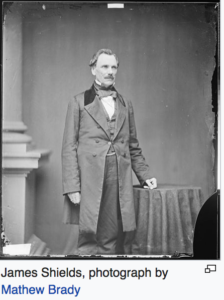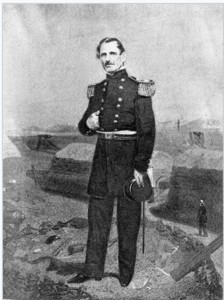
To set up the events that later transpired between Lincoln and Shields, without turning this post into a tome, I hope you will forgive my necessary jumps in time and assumptions of knowledge below. Bear with me.
James Shields- Where’d he come from?
James Shields was born in Dungannon, Ireland. His 1840 U.S. Citizenship application shows a May 17, 1810 birthday, his tombstone in Carrollton, Missouri shows a birthdate of 5-18-1810, but scholars who have examined Irish records believe he was actually born May 6, 1806.
By about age five, James’ father died, leaving his mother Catherine to care for three sons. Luckily for them, the Shields’ family owned land—an unusual thing for a Catholic family at that time. In fact, it appears that James Shields was born into a family of relative prosperity, though those fates might have later changed during the 1847 Irish Potato famine.
James first attended a “hedge school,” which was Irish Catholic defiance against English penal education laws that were prejudiced against them. The schools were often run by itinerant teachers who taught Gaelic and secretly added Irish history to regular academics. Later, James was enrolled in a Protestant grammar school in Carrickmore, Ireland, where he was taught Greek, Latin, Irish, English. At some point, he entered divinity school but left when he decided to migrate to the U.S. as a young man—arriving between the ages of 18-24. By all indications, the 5’9″ man was intelligent and book-loving.
It is unlikely that Shields came to America with any notable amount of money. He worked as a merchant sailor for a while, though he took a three-month break from the sea to teach the children of a Scottish laird when his ship ran aground nearby. He did return to the sea, but while entering New York Harbor one day, a sudden wind caused a flailing ruckus of swinging masts and other ship parts. In the fray, Shields was injured. For three months, he recuperated in a hospital run by nuns. It was then that he de decided to give up sailing and remain in America.
Shields, Law, Politics, Lincoln
Time passed and James Shields settled in Kaskaskia, Illinois, where he opened a school for adults and children until he set his sights on a law career. He worked as a law clerk during two years of intense study, then passed the bar exam in 1832.
People of Irish descent faced a great deal of prejudice in the United States at the time, but Shields was a determined and driven man and deeply loyal to his chosen country. An eager soldier, he enlisted in the Army to fight in the Mexican War and the Black Hawk War, rising in rank to Brigadier General. It would not be his last military action.
By late 1830’s, Shields (a diehard Democrat) and Abraham Lincoln (a Whig leader) were both legislators and lawyers. When the Illinois capital was moved to Springfield, both men moved with it.
Lincoln, being a progressive kind of politician, lobbied with his party and won financial concessions to improve Illinois infrastructure. In other words, Illinois increased its debt at the suggestion of Lincoln and his friends. That’s important to consider when we’re tempted to demonize Shields and other government officials later. Such debt was justified by the needs of citizens, but it came with a more profound cost. There were a number of causes for the 1837 U.S. Financial Panic and ultimate Illinois crisis, including Andrew Jackson’s 1836 Specie Circular, the closing of the Second Bank of the United States, defaulted foreign loans, and mismanagement of state finances and debt. The money of the State Bank of Illinois was suddenly worth a fraction of its face value, and some banks closed.
Shields & Lincoln Work Together On an Issue in 1837
 Shields didn’t entirely agree with his Democratic party about how to address the problem. He called for a bipartisan solution to bail out the banks, calling on Whig leader Abraham Lincoln to collaborate on a plan of action.
Shields didn’t entirely agree with his Democratic party about how to address the problem. He called for a bipartisan solution to bail out the banks, calling on Whig leader Abraham Lincoln to collaborate on a plan of action.
A quick aside: When the State Bank of Illinois was first chartered in ~1816, a legislative act stated that, in the event of bank failure, the state’s governor, auditor, and treasurer were “authorized and required” to refuse the bank’s money in payment of taxes. Remember that in a moment.
The Shields-Lincoln proposal made its way into law, and it essentially prevented more banks from being shut down. It worked. For a while
In 1841, Shields became Illinois’ state auditor of public accounts. In 1842, the financial crisis spiked. There was a run on the banks—people rushed to withdraw their savings, removing monies from circulation. When a third bank went bust, Shields took drastic action. As State Auditor, he did what he was “authorized and required” to do. He, the governor, and the treasurer issued a proclamation that required all Illinois citizens to pay their taxes in gold or silver (specie) rather than with State Bank of Illinois bank notes. The proclamation incited Lincoln’s politically driven Rebecca letter—which led to Shields challenging Lincoln to a duel. Read my picture book Abraham Lincoln’s Dueling Words to learn more.
How did Lincoln and Shields Work Together Toward a Common Cause During the Civil War?
Though they appeared to have maintained a courteous professional relationship after the “affair of honor,” I found no evidence that Lincoln and Shields were close friends, which isn’t surprising since Shields and Stephen Douglas, one of Lincoln’s biggest political rivals, were especially chummy. When Douglas ran against Lincoln in the 1860 presidential election, Sheilds stumped for Douglas, which means he campaigned for him. But, when Lincoln won the presidency and South Carolina seceded from the Union—sparking ten more states to follow—Shields vowed to help Lincoln save the Union.
On April 12, 1861, when Fort Sumter was fired upon and the Civil War began, fifty-five-year-old Shields was ready to re-enlist in the army. He was soon called on as a commander with the rank of brigadier general. He was involved in several campaigns, including a skirmish with Confederate Stonewall Jackson. Even a bullet to the shoulder didn’t sway Shields from his military devotion and acumen. You can read a bit about some of his Civil War battles here. Lincoln suggested that Shields be promoted to Major General, a two-star rank, but other military officials disagreed.
Though Shields didn’t work directly with Lincoln during the Civil War, both men fought in different ways for the same common cause.
After the war, Shields went on to become governor of the Oregon Territory, and he remains the only U.S. senator to have represented three states: Illinois, Minnesota, and Missouri.


Hi,
I’m currently engaged in research about General Shields’ life, and am interested in the reference to his having studied Irish in the hedge school. Can you give me a source that would confirm this?
Regards,
Justin Scannell